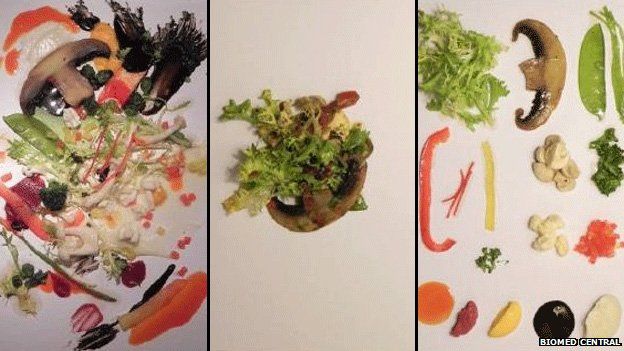Kandinsky painting salad 'tastes better'
- Published

The humble salad is not known for its artistic qualities.
A sprinkling of lettuce leaves and some neatly chopped salad vegetables are usually enough to satisfy even the most discerning of palates.
But now scientists have created an abstract masterpiece made entirely out of salad - no less than Kandinsky's Painting Number 201.
Food arranged to resemble a work of art tastes better than when ingredients are either arranged neatly or piled together on a plate, they say.
"It might be just because it looks more appealing," says Prof Charles Spence, of the Crossmodal Research Laboratory at the University of Oxford.
"It may also be when you see that presentation you can see that someone has put effort into it and that may convey expectations and impact on the experience.
"Maybe it is the intrinsic aesthetic appeal of the artful presentation."
It has long been known that our senses are intermingled.
For example, the colour of food, the cutlery we use and the atmosphere of a restaurant can all influence our perception and enjoyment of a meal.
Artistic impression
The latest study, in the journal Flavour, suggests artistic influence can also enhance a diner's rating of the flavour of a dish.
Sixty participants took part in an experiment to sample three salads and rate them for flavour and enjoyment.
Chef Jozef Youssef worked with the Oxford team to re-create one of Wassily Kandinsky's abstract paintings.
The cruciferous creation was compared with a salad that had been thrown together in the centre of the plate and a salad that had been laid out neatly but in a non-artistic way.
The three salads contained the same ingredients:
- vegetables (mushrooms, broccoli sprouts, endive, pepper, cauliflower sprouts and mangetout),
- sauces (beetroot puree, carrot puree, cauliflower creme, mushroom essence and pepperoncino oil)
- condiments (olive oil and sea salt)
The Kandinsky-inspired salad was liked more than the others, and was said to taste better.
Participants were also prepared to pay twice as much for it.
According to the researchers, it reflects the idea that the value of art is "rooted in the assumptions about the human performance underlying its creation".
They write in Flavour: "Diners intuitively attribute an artistic value to the food, find it more complex and like it more when the culinary elements are arranged to look like an abstract-art painting."
Visceral visual cues
Food and art historian Janine Catalano says the study helps to confirm that our "tastes" are affected by a combination of the senses - and that the presentation of food has real effects, whether viewed or, literally, consumed.
"It is not only chefs that use this to their advantage," she says.
"Artists through the ages have employed these visceral visual cues associated with food and eating, from Luis Melendez's mouth-wateringly luscious still lifes and Joachim Beuckelaer's abundantly inviting market scenes, to Salvador Dali's evocations of the disgusting capacities of food with amorphous, dripping fried eggs and rotting rashers of bacon."
Prof Spence thinks the research could also have practical applications, by encouraging healthy eating.
"Chefs are explicitly or more subtly taking inspiration from visual arts and painting," he says.
"And we may be able to get people to eat more salad by changing the presentation."
It seems that the old idea that we eat first with our eyes may be true.
- Published26 June 2013
- Published20 March 2014
- Published15 March 2014
- Published9 December 2012